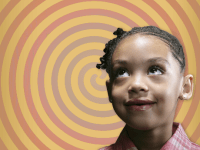Embracing Student Creativity With a Wonder Shelf
Providing math students with manipulatives and art supplies can bring excitement, engagement, and elements of a Makerspace into the classroom.
As a high school math teacher, it was important for me to create a learning space that welcomed on-demand wonder and exploration. I knew that I planned to have a few essential hands-on math tools, and in the last few years, I also knew that I needed to have other items that were essential for providing kids more creative freedom. With a few containers, manipulatives, and supplies, along with some technology, I created a space that my students would go on to name "the wonder shelves." What you are about to read was not an overnight process, but one that grew over an eight-year span.
Components of the Wonder Shelves
A few years ago, the wonder shelves housed our classroom math manipulatives sorted into individual or group containers. I knew that I wanted our learning tools to be accessible as needed, but I also knew that I needed to keep them organized to save time. Using disposable food containers individualized by purpose or tool, I created a system for organizing tools that kids could explore during lessons, after lessons, and sometimes before or after school.
As I got to know my students, I began learning about their other interests outside of class. I found that many were dabbling in the creative arts, so I added quite a few things specific to those pursuits during the course of the year. Our shelves grew to hold art pads, sketchbooks, air-dry clay, molding tools, various markers, art pencils, beads, string, Legos, K'nex, and glue.
While this may sound a bit much for a high school algebra 1 or geometry class, it was amazing to see students use their downtime to explore their interests, create, and learn. On many occasions, I found them creating items specific to areas that we were studying, like making bracelets or necklaces that involved recursive or geometric sequences, and then challenging their peers to determine the equation. They created structures using Legos and K'nex to build us a geometric city where we explored concepts like taxicab geometry, angle pair relationships, and even measurement.
Through our school’s Upward Bound Math and Science program, which I sponsored, we inherited a Lego Mindstorm kit and that opened up an entirely new world to students in the area of robotics. We had no idea how to actually program the robot, but the Mindstorm kit didn't sit idle on the shelf. We learned together, and in the process, we developed meaningful relationships that enhanced our growth in and out of class.
When I received classroom technology like laptops and iPads, they were housed on the wonder shelves and not locked away in a cabinet. Doing this created a space where learning extended to whatever students could create and interact with on a device. I was pleasantly shocked to turn on an iPad and see a stop-motion creation using clay to illustrate changes in volume of a cylinder -- and this was something that I hadn't assigned! When you give kids space and access to explore, this is what can happen.
Our latest addition was a MakeyMakey after I learned about it through Twitter. I never told the kids what it did. They looked it up on their own, and before long, it became the hit of the wonder shelf as if their daily goal was to try "crazy" ideas and test them. These were the moments that the early-morning Edmodo alerts came through. Kids wanted to make sure that I was there!
From Wonder Shelf to Makerspace
What I created in my classroom space was a place where kids could explore learning and create. Until this summer, it never occurred to me that what we had developed was in essence the "theoretical" definition of a Makerspace. As I talked about this space over the summer, many teachers asked how we did this with administrative holds on creativity outside of the curriculum. Simply put, my students and I had designed in-class learning that adhered to our goals. What kids did when they met those goals or on their own time was fair game, and this space gave room to the idea of learning beyond our standards.
The wonder shelves also meant that my students, with a majority of them falling into more marginalized populations, were provided experiences that they would not have had in any other learning venue.
Do you have a wonder shelf or something similar in your classroom? Please tell us about it.
